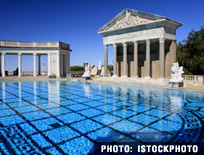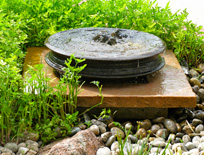design
Every time I open a landscape trade magazine, I’m bombarded by ads from just about every paver manufacturer on the planet. From the newest faux-stone concrete pavers and ADA-compliant bricks to granite, flagstone, mica and other slab species, we have more choices than ever before for our projects. Some professionals approach this wealth of possibilities and play it safe – not caring so much about what’s the latest and greatest but focusing instead on what’s most familiar and time-tested and being interested in little more than providing clients with surfaces that can safely be walked on. Fortunately, however, there are lots of us who take a different view, putting care and thought into the materials we select for our walkways, patios and terraces and working closely with our clients to make certain the resulting surfaces meet their needs. In other words, there’s
I just don't get Hearst Castle. Why should we celebrate the gross-scale purchases of historical artifacts and period-inspired structures by a wealthy American whose main pleasures seem to have involved amusing himself and overwhelming others? I am willing to concede that Hearst's San Simeon compound and collections impress
The warmth and solid heft of aged, cast brass are the hallmarks of the antique rice cooker — a treasure acquired in India several years ago — that now makes a statement to visitors approaching a modern Colorado home's front door. Forged more than 150 years ago using the same techniques employed in making
It might sound a bit strange to put it this way, but when it comes to design work, one of the most useful things you can do is to think about how you think about design. If you're like me and have been working as a watershape designer for more years than you care to count, much of what you do is now
If you want to gain a full appreciation for classic fountains, pools or waterfeatures, you really do need to pack your bags: Seeing their beauty, power and subtlety at first hand gives us the opportunity to
One of the great things about watershaping is how the work can lead you to unexpected places where you sometimes encounter vastly different ways of doing things. In the past few years, for instance, my design work has led me to design a number of projects in the great open spaces of western Canada – many of which have been built by Gene Brown of Valley Pools in Kelowna, British Columbia. Working with this true professional has taught me a great deal about the precision and power that comes in using poured-in-place concrete as a medium and, as a result, has greatly influenced my thinking about how watershapers everywhere should strive to elevate their own standards of construction. My northward migration began with small steps. In fact, I started off with Valley Pools simply as a consultant for hydraulic and mechanical issues, exchanging plans with Brown and helping him ensure the functionality of some of the more complex systems he found himself doing. At first, I did little more than flesh out the plans mechanically, but I couldn’t help noticing that he was finding some interesting projects – and also observed that he was one of those watershapers who had completely dedicated himself to excellence in all facets of the work. Our usual exchanges were set aside, however, when one day he sent me a set of plans that had been produced by an architect in collaboration with
Last month, we began our discussion of a large pond, stream and waterfall system for a historic upper Midwest estate found on the forested shore of a scenic lake. As related there, the project was to include three major ponds and a series of complex waterfall structures connected by streams rising close to the top of the gently sloping property. To sum up, the space we were working with measured approximately 300 feet wide and 800 feet long – a large section of a 35-acre estate marked by scores of mature trees that largely governed the watershapes’ configurations. Moreover, as there were no natural rock formations or outcroppings on site, we faced the need to
If there’s ever been such a thing as a match made in heaven, swimming pools and landscape lighting lay a strong claim to that perfection. Separately, they take little-used spaces and transform them to all-day hubs of activity and sources of constant beauty. Together, however, the magic starts, with pools and landscape lighting systems accentuating each other’s virtues in ways that are tough to quantify or adequately describe. To landscape lighting designers and installers, pools offer a
Automatic swimming pool covers are wonderful in a number of ways: They increase safety, save energy, limit evaporative water losses, keep debris out of a pool and can even reduce chemical consumption. As a watershaper, I want these devices to be trouble-free so they will perform with nothing more than routine maintenance and my clients can
It comes up almost every time: Our clients tell us they want to increase the energy efficiency and overall environmental friendliness of almost everything they plan to do with their homes, landscapes and watershapes. It truly is a “green revolution,” and, as is true of most clients, they’re looking to us for guidance in what can be accomplished. From out perspective at Rosebrook Pools in Libertyville Ill., this trend kicked into high gear about three years ago – not surprising at a point when gas and other fuel prices started to soar. We’re proud of the fact that we saw this coming and had, for about five years already, been considering and implementing eco-considerate features into our watershaping and landscape work. In doing so, we took many of our cues from the






















